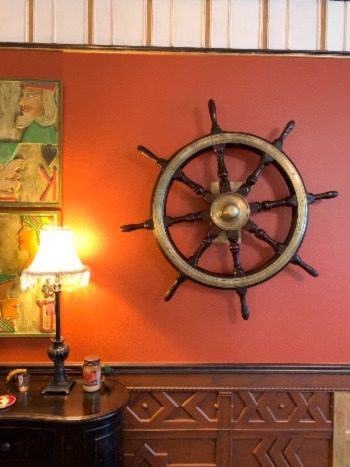Steering wheels are so important, they’re how we get from Point A to Point B, then C and D. So I bought one, just as an interesting piece for display in my “man cave” room. The sellers told me this ships wheel was made for a vessel in 1790. It was sitting in New York and delivered to me last week. Then I spent a week getting to know my new [old] ships wheel in the garage while I examined it, and cleaned it up before successfully hanging it on the wall today.
It spent a week in my garage because I had to figure some things out first. One epiphany was that this puppy wasn’t going to hang over my fireplace [my original intention] because that would have required removing some stone and modifying that wall because it weighs 45 lbs. And would I like for it to spin freely or mount in a fixed position? The best answer was to mount it on the wall so that can spin in both directions, that’s what wheels do, they spin! Turns out though that it doesn’t spin very fast nor without emitting some really weird creaking noises. Still, it does turn in either direction, though I think it prefers turning right over left[?] just by the noises I hear it emit. LOL!
[edited]
My interest is to find out more than the seller knew about its voyages – what ship was this ships wheel originally made for? Below I have listed what I know so far, besides the fact that it is an antiquity as opposed to being built for decorative purposes.
Here is what I know so far:
– Manufactured in England of solid oak and with brass center core and two brass plate rings, one on each side.
– The original construction included large brass slot screws which were used on ships back in the late 1700’s to early 1800’s. Much later, according to a Maritime Curator, copper pins replaced each copper screw located over a spoke, connecting all the way through both brass plates on either side. These copper dowels [essentially] made of solid copper were then hammered down flat. Copper does not rust like iron and was used on ship hulls for centuries to keep things like shipworms from attaching themselves to ship hulls.
– Back then it was common for shipmates to mark the one handle that indicated a neutral or straight rudder position on the ship. One handle does appear to have been scraped flat in front to reveal raw wood, and is quite worn all the way down to the center hub. I’m thinking it looks like this peg handle was then later stained to return the color back or try to match the original wood finish?
Many thanks go out to Justin Parkoff of the Maritime Museum in Texas for his inputs on this piece. I would like to hear from anyone who knows, or knows someone that knows more about this era for ship parts. Even if you have suggestions for resources where I may be able to find more answers for this piece, please let me know in your comments and as always, I thank you in advance – Bon Voyage!


https://www.texasmaritimemuseum.org/
These folks may be able to give you a good start. Is there a name of any sort in the center brass hub. It would be cool to find the history and registries.
That’s a good idea, I have not searched that site yet so thanks! No stencils on either side of brass hub, the center cap is removable and I searched inside there as well, nothing yet to identify.